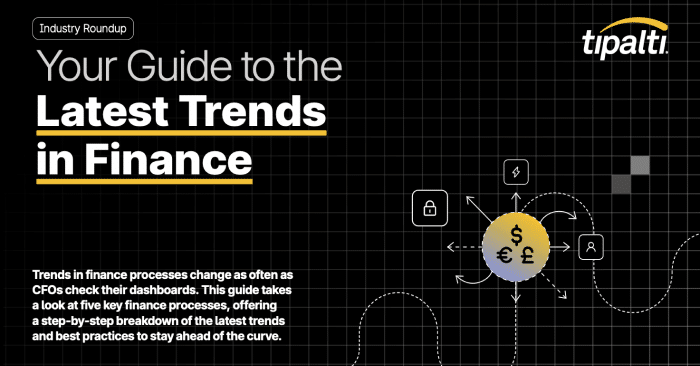
Finance trends shift fast—explore 5 key processes & tips to stay ahead.
Fill out the form to get your free eBook.

Trends in finance processes change as often as CFOs check their dashboards. This guide takes a look at five key finance processes, offering a step-by-step breakdown of the latest trends and best practices to stay ahead of the curve.
The unpredictable economic outlook creates a pressing need for companies to fully automate their finance function.
Automation is critical to the changing nature of modern finance departments. Finance now needs to go beyond making the numbers add up and must be able to provide strategic insights to the C-suite, investors, and the wider business.
Relying on manual finance processes hinders the ability of finance teams to step up and prove their value, due to slow non-automated workflows, alongside carrying the risk of human errors.
These issues become heightened further for growing businesses due to increased transactions, leaving staff and resources stretched further. There’s also the issue of the finance department overhead becoming more expensive due to needing to add additional headcount to support the influx in transactions.
It’s also essential to automate finance processes to engage team members who prefer to work on more fulfilling tasks than processing transactions.
In this piece, we’ve identified the key workflows to automate to allow finance teams to demonstrate agility and steward their companies through today’s tough economic times.
Accounts Payable
Manually led accounts payable processes are riddled with inefficiencies. This includes manual reconciliations, using bandwidth to keep up with changing global regulations, and slow data output, impairing the ability to generate real-time data.
There is also the risk of damaging supplier relationships due to not paying them on time, from staff falling behind on payment runs by being stretched and rushed off their feet from manual processing.
Manually processing transactions also result in human-generated errors, such as transposition errors, with team members entering the last two digits of a transaction back to front.
By automating your AP function, finance teams can increase processing speeds, minimize errors, and boost the availability of real-time data. Leading accounts payable vendors incorporate a range of features, including data capture, approvals routing, and automated governance.
The availability of physical and virtual corporate cards integrated into your automation solution can also lessen the workload on finance teams and ensure employees comply with the business’s spend policies when accessing products and services. Automated accounts payable tools will automatically reconcile and sync these card transactions with your ERP.
Global Payments
The rise of the digital economy means that businesses now work with suppliers all over the world.
Manually optimizing cross-border payments can be mind-boggling. Paying overseas suppliers adds extra complexity due to finance leaders needing to navigate a range of payment options, each with its own restrictions, cost per transaction, and consideration of FX rates.
Picking the wrong overseas payment type can significantly increase costs and delay payments.
Using an automated global payments solution for payment runs will allow you to ensure payments made to overseas suppliers are settled in the most cost-effective way and help you stay on top of tax compliance and global regulations.
Vendors with full coverage of global payments also streamline payments operations and save time because finance team members only have to use one set of login credentials.
Procurement
Procurement isn’t a value-adding exercise in businesses, but it’s critical to get it right. Weak controls provide limited visibility of company spend and can lead to uncompliant and fraudulent transactions.
Automated procurement tools strengthen controls and improve efficiencies by making it easier to generate multi-layer approvals, manage contracts, generate POs, and ultimately give CFOs visibility on current spend and future liabilities. This allows them to pivot their business strategy at short notice to respond to market conditions.
Friction is also removed between the finance function and other departments by outstanding approvals resulting in auto-generated chaser emails.
Employee Expenses
Employee expenses are a common pain point for CFOs. Colleagues tend to submit expenses late or in an incomplete state, holding up the production of monthly management accounts.
Relying on spreadsheets also results in a poor employee experience due to staff having to devote significant time filling out expense reports and frustratingly waiting for out-of-pocket expenses to be paid back.
Moving to an automated end-to-end employee expenses solution will help improve the experience for all parties, save time, and speed up the accuracy and flow of financial data.
Leading tools have mobile apps that allow employees to submit and file their expenses on the go. Employees can take photos of their receipts, upload them to the app, and have the data extracted for reports. Then it is just a matter of line managers responding to automated prompts for approval, and employees are reimbursed for their expenses.
